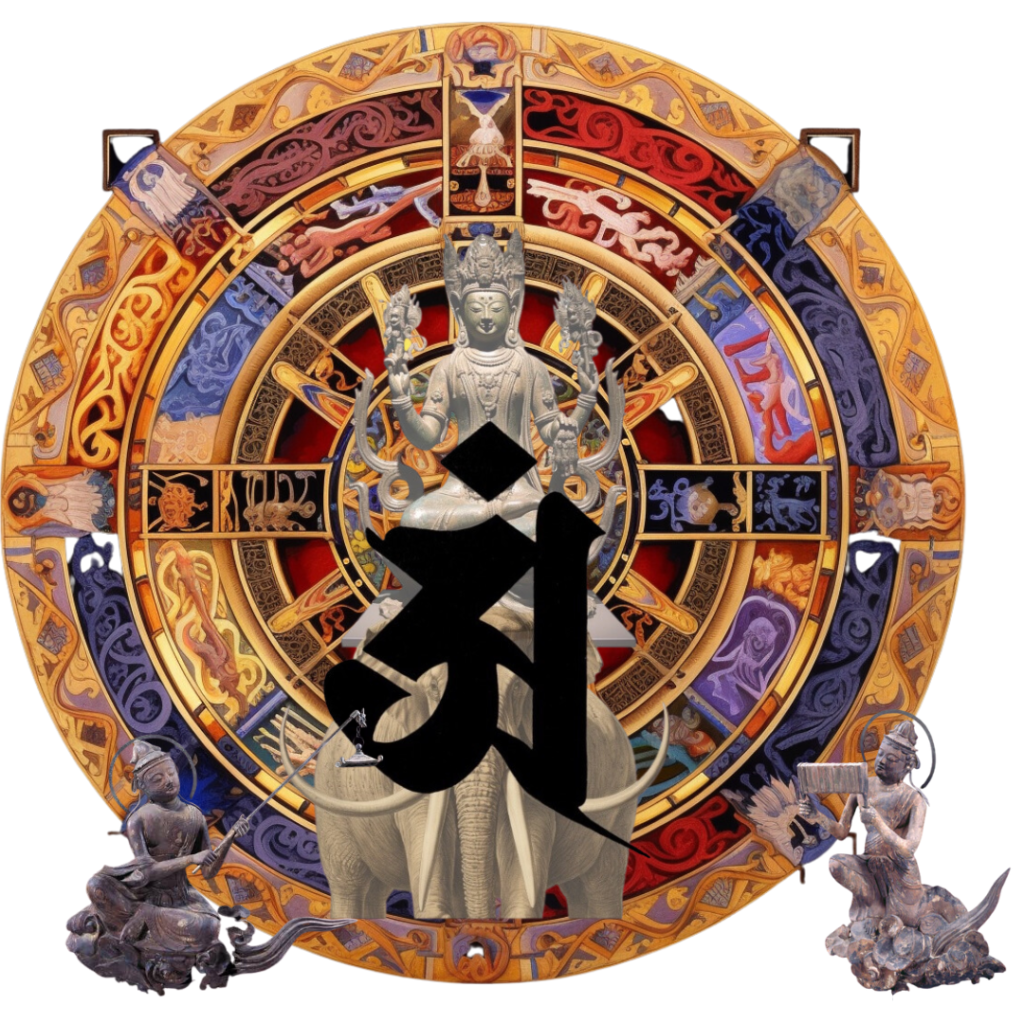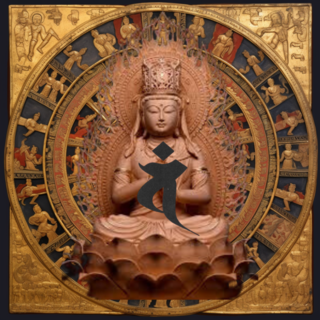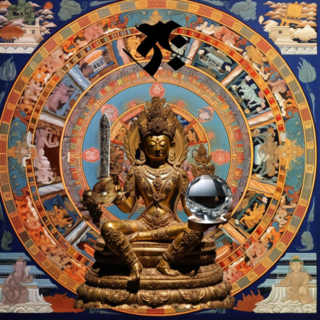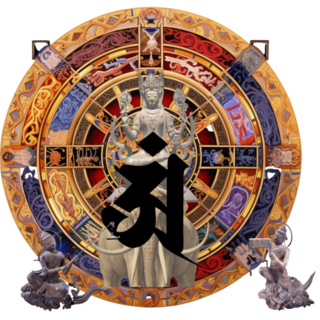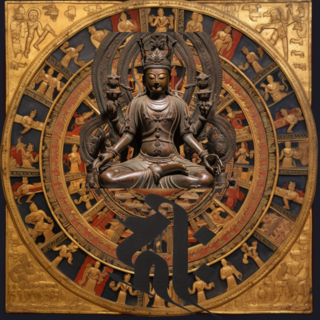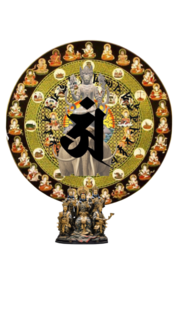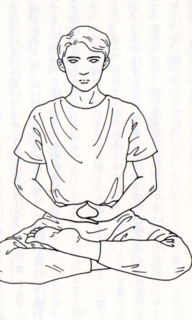
では瞑想に入ろう。
坐は半珈鉄坐。坐蒲をもちいる。瞑想の手印を組もう。これが初歩的瞑想の
基本姿勢である。(この図では法界定印であるが、後出のアーカーシャームドラーをもちいる場合もある。瞑想の基本姿勢については『輪廻転生瞑想法』に、くわしく解説しているので、かならず読んでいただきたい)
瞑想の修行は、二つの領域から成り立つ。
ひとつは精神集中法(である。
心を集中するとは
これについて少し解説しよう。まず、シャマタ(止)である。、禅における公案、また、祈りを捧げるとか、経文を読む、真言を唱えるなども、精神集中法のひとつである。要はひとつのことに心を集中し、そこに〃止”まり、動かないことである。
これは、ひとっのことに心を集中するのである。
数息観がそ‘の代表であるが、、とで’‐ ことてことに意識を集申し、他のものに心を向けない、これを積極的に意識的におこなうのであるひこれは修行のはじめの過程として、だれでも通るものである。
この精神集中の状態は二つに分けることができる。
ひとつはこ息識的精神集中」で、ひとつのことにつぎの段階が、「無意識的精神集中しの状態である。これは、高度のもので、
意識的精神集中をつづけているうちに、習練によって条件づけられ、ついに、とくに意識しないでもひとつのことに心を集中することができるようになる。
これによって無意識の意識層をつうでは絶対に統御できない無意識の意識を、ある特定の対象に向けることができるようになるのである。
心の流れにまかせるとは
つぎに、ビパシャナ(観)である。
これは、ひとつのことに注意をとどめない。心の動きのひとつひとつに心を
向けていくが、ひとつのことにとどまっていない。心の流れにまかせるのである。
これにも、「意識的瞑想」と「無意識的瞑想」がある。
「意識的瞑想」は、表面意識が心の流れを観ている。
「無意識的瞑想」は、深層意識の心の流れそのものになっている。
では、その深層意識の流れを観ているものはなにか? だれが深層意識の流
れを観ているのか? それは「無意識的精神集中」の心である。
だから、「止」と「観」は密接な関係があるのである。いまおこなわれている瞑想のほとんどは、「止」か「観」か、どちらかにかたよっている。禅は「止」にウェイトがかかり、瞑想(としてやっているもの)は、「観」が主である。しかし、「止」を完成した「観」でなければほんとうの瞑想ではなく、「止」でとどまって「観」に入らない定は、これまたほんとうの瞑想ではないのである。
「止」と「観」はおなじように修せられなければならない。そうして、非常に高度の瞑想(観)をするためには、おなじように非常に高度の巣中(止)が体得されていなければ不可能なのである。
では「意識的瞑想」と「無意識的瞑想」とはどうちがうのか?
ひと口でいうならば、
意識的瞑想は「個の世界」を観、無意識的瞑想は「全の世界」を観る。 ・
といったらよいであろう。
意識的瞑想は「自分だけの世界の流れ」を観るのである。
無意識的瞑想は「人類そのものの(世界の)流れ」を観るのである。いや、
もっと拡大した世界だ。「宇宙そのものの流れを観る」といったらよいであろう。
無意識の意識層には、原初からの人類の記憶がすべておさめられている。いや、人類以前からの記憶がすべて秘められている。
わたくしは、『輪廻転生瞑想法I』で、このことについてのべている。「個体発生」と「系統発生」の意識と記憶について語った第二章を、もう一度読み返してみていただきたい。
瞑想の呼吸法は、四種の呼吸法から成り立つ。
一、長出入息呼吸法
二、長山息呼吸法
三、反式呼吸法
四、強短息呼吸法(火の呼吸法))
である。

四種の呼吸法
この本で教える瞑想の呼吸法は、四種の呼吸法から成り立つ。
一、長出入息呼吸法
二、長山息呼吸法
三、反式呼吸法
四、強短息呼吸法(火の呼吸法))
である。
簡爪に説明すると、一の長出入息呼吸法は、出る息、入る息、どちらも、できるだけ細く長く深く呼吸する。一呼吸に二十秒から三十秒、一分くらい、時間をかける。
二の長出息呼吸法は、出る息のみをできるかぎり細く長く吐いて、吸う息はつうに吸う。
三の反式呼吸法は、ふつうの呼吸とちかって、息を吸うとき、腹部をひっこ
め、息を吐くとき、腹部をふくらませる。ちょうど逆になるわけである。
四の強短息呼吸法は、「火の呼吸法」とよび、片方の鼻孔を指で押さえて閉
じ、片方の鼻孔で強く短く呼吸する。
それでは、四種の呼吸法の訓練を説明しよう。
長出入息呼吸法の訓練
鉄坐、あるいは椅子坐、いずれにしても、頭部、頚部をごく自然に、まっす
ぐ、きちんとした姿勢をとる。ただし、あまり緊張しすぎて力んだり、硬直し
たりしてはいけない。ゆったりと、リラックスすることが大切である。
そのためには、頭部、頭部の緊張を解くために、前頭部を心もち前に出し、
ド顎を少し中へ引くようにして、頭部をやや下げるようにするとよい。同時
に、前胸部も少しひっこめるようにし、腹部は少し前に出し、両肩は力を入れ
ず、自然な盗勢をとる。背中は心もち前に曲げ、腹部の容積を大きくするよう
にする。
口と唇はごく自然に軽く閉じる。両眼も軽く閉じるが、かすかに外光を感じ
る程度にひとすじの隙間を残す。すなわち半眼にして、視線は、鼻の先、鼻頭
に持っていく。
肛門をきゅっと締め、ヒヘ引き上げるようにする。
まず、最初、帷く息を吸い、ついで口をすぼめ開き、力いっぱい吐き出す。
下腹部に力をこめ、ヒ体を少し前に折りかがめるようにしながら、吐いて吐い
て叶き尽くす。このとき、前に書いたように、体中の悪気、不浄の気をことご
とく叶き川してしまう気持ちで、鳩尾が背骨にくっついてしまうくらいに、吐
くのである。吐き尽くしたら、また大きく吸い、二、三回、これをくり返す。
大事なことは、呼吸法をはじめるときには、かならず、まず最初に息を吐く
ことである。まず吐いて、つぎに吸うときから第一回の呼吸がはじまるのであ
る。
歯は軽くかみ合わせて、かみ合わせた歯の間を通して、ゆっくりと息を吐
く。歯は上下が軽く2 れるか2 れない程度で、決して強くかみ合わせてはいけ
ない。
自然に、長出大息呼吸法に移る。
まず、軽く息を吸う。
歯の間を通してゆっくりと息を吐き終わったら、今度は唇を閉じ、歯をきち
んと合わせて、鼻からゆっくりと吸うのである。
少しずつ、時間をかけて、鼻から空気を吸う。このとき、鼻から大ってくる
空気の量をできるだけ少なくするために、鼻をすぼめて鼻腔をせまくする。こ
うすると、大ってくる空気の量が少なくなるだけではなく、せまくなった鼻腔
の壁が空気でマサツされて、その刺激が脳に伝わり、脳の興奮を静める効果も
あるのである。
よた、息を吸い込むとき、舌の先を、上顎部(上の正面の歯ぐきのやや上部、つり、竹脈ルートの願文のところである)につける。なぜっけるのかというと、わ
たくしけ、さきに、任脈と督脈のニルートは、元来一本の線であるとのべた。
しかし、じっは、口のところでとぎれているのである。これを、舌の先で接続
させるのである。これによって、じっさいに、任脈・督脈のニルートは、一本
のルートとなるのであ今(ここから意念との共同訓練に入っていくのだ)
そこで、ごく自然に息を吸い込んでいく。
このとき、息を吸い込む鼻の奥から、(任脈ルートの)鳩尾、中胱、神闘(臍)
を通って、田刀性は気海(臍の下約四センチ)、女性は関元(臍の下約八センチ)のと
ころまで、一本の気管(プラーナ管)が通じていると観想せよ。太さは細めのストローくらいで、赤色である。
この気管の根本、つまり根管部(気海、関元)に、胞宮という三センチ四方くらいの特殊な細胞の場のあることを意識せよ。胞嚢という、うすいオレンジ色を帯びた透明の袋と考えてもよい。鍛錬によって収縮・拡大するから、嚢と考えたほうが把握しやすい。
静かに深く息を吸い込んでいく。気管を通じて息はまっすぐに胞嚢に吸い込
まれていく。吸い込む最初、鳩尾は軽くひっこみ、このとき、胞宮に強く意識
をかけ、少し力を入れる。息が吸い込まれるにしたがって、鳩尾は2倍くらみ、収縮していた胞嚢もふくらんでいく。(注意。あとでのべる「反式呼は、この逆になる)
息を吸い終わったら、もう一度、軽く息をのみ、鳩尾は十分に落とし、肛門をぐっと閉じ、胞宮にウムと力を入れる。この力を入れるとき、同時にかならず鼻からちょっと息を漏らす。これが非常に大切で、これをやらないと、胸から頭部にかけて圧がかかり、体を痛めるおそれが出てくる。腹式呼吸をやって、頭痛を起こしたり、内臓下垂で苦しんだりするのは、これを知らないからである。禅宗の原田祖岳老師が、原坦山和尚の極端な下腹人力禅をやったとこ
ろ、頭が鳴って苦しくなった。また腸の位置が変則的になって難病をしたと本
にいておられる。注意が必要である。
この肛門を締めて、胞宮にウムと力を入れる動作を、二、三回おこなう。、長山息呼吸に移る。
胞官に。役と力をこめ、下腹部を収縮させながら、どこまでも腹の力をもって静かに息か叶き出していく。 くらんでいた胞嚢がしだいにしぼられ、収縮していく。
このとき、息を吐き出しながら、それまで、上顎部につけていた舌を離し、
吐き出す息に乗せるような気持ちで、低い声で真言を誦する。
「オン」
真言を誦しながら息を吐き出していく。静かに、ゆっくりと、できるだけ細
く長く吐き川していく。がすっかり出てしまうと、下腹はくぼみ、腹壁が背
骨にくりつくような気持ちになる。つまり、そうなるような気持ちで吐ていくのである。
吐き出し終わったら、また、静かに鼻で吸う。吸うときは、舌を上顎につけ
ること。前とおなじである。
吸い込んだら、前と同じ動作で吐き出していく。前とおなじように、吐き出
しながら、真言を誦する。
真言はつづいて、
「シンタマニ」
「ダト」
「ウン」
で、これを、それぞれ、吐くひと息ごとに、一句ずつ、唱える。
「オン、シンタ。マニ、ダト、ウン」
この真言は、守護仏、仏舎利尊(輪廻転生瞑想法の本尊、準胆尊の本体)の真言
である。深く念ずることにより、守護仏の加護を得て、魔境に陥ることなく、
無事、修行を成就するのである。
この長出人1 呼吸法は、一呼吸についての時間は問わない。できるだけ細く長く、長出入息させるのである。
長出息呼吸法の訓練
前の、長山人1 呼吸法は、出る息、入る息、ともにできるだけ長く細く呼吸するものである。できるだけ細く長く、というだけで、どれほどの時間をかけて細く災く岬吸するのか、という時間は問わない。
Concentration (stop) and meditation (view)
Let's get into meditation.
The seat is a half-iron seat. Use zafu. Let's set a sign of meditation. This is a rudimentary meditation
This is the basic posture. (Although it is a legal seal in this figure, it may also use the Aker Shamdler described later. The basic posture of meditation is explained in detail in "Reincarnation Meditation Method", so please be sure to read it. )
Meditation practice consists of two areas.
One is the mental concentration method.
To concentrate on your mind
Let's explain this a little. First is Shamata (stop). , Koan in Zen, praying, reading sutras, chanting mantras, etc. are also one of the methods of concentration. The point is to focus on one thing, stay there, and not move.
This focuses on one thing.
The view of several breaths is the representative of that, but in and out, it is a practice that attracts attention to things, does not pay attention to other things, and actively and consciously does this. As the first process of, anyone goes through.
This state of mental concentration can be divided into two.
One is this sensible concentration, and the next stage is the "unconscious state of concentration. This is a high degree.
As you continue to concentrate consciously, you will be conditioned by practice, and finally you will be able to concentrate on one thing without being particularly conscious.
This makes it possible to direct the unconscious consciousness, which cannot be controlled by the unconscious consciousness layer, to a specific object.
To leave it to the flow of the heart
Next is Bipashana (view).
This does not stop at one thing. Put your heart into each movement of your heart
I'm going, but it's not just one thing. Leave it to the flow of your heart.
There are also "conscious meditation" and "unconscious meditation".
In "conscious meditation", surface consciousness is watching the flow of the mind.
"Unconscious meditation" is the flow of the mind of deep consciousness.
Then, what is watching the flow of deep consciousness? Who is the flow of deep consciousness
Are you watching this? It is the mind of "unconscious concentration".
Therefore, "stop" and "view" are closely related. Most of the meditations that are being practiced now depend on either "stop" or "view." In Zen, "stop" is weighted, and in meditation (what is done as), "view" is the main. However, if it is not a "view" that completes the "stop", it is not a true meditation, and a decision that stays at the "stop" and does not enter the "view" is not a true meditation either.
"Stop" and "view" must be mastered in the same way. Then, in order to perform a very high degree of meditation (view), it is impossible without mastering a very high degree of nesting (stopping) as in the same way.
Then, what is the difference between "conscious meditation" and "unconscious meditation"?
In a nutshell,
Conscious meditation sees the "individual world", and unconscious meditation sees the "whole world".・ ・
It would be nice to say.
Conscious meditation sees "the flow of your own world".
Unconscious meditation sees the "flow of mankind itself (in the world)". no,
It's a more expanded world. It would be nice to say, "Watch the flow of the universe itself."
The unconscious conscious layer contains all the memories of humankind from the beginning. No, all the memories from before humankind are hidden.
I mentioned this in "Reincarnation Meditation Method I". Please reread Chapter 2, which talks about the consciousness and memory of "ontogeny" and "pharmaceutical development."
The meditation breathing method consists of four types of breathing methods.
1. Long breathing method
2. Nagayama breathing method
Third, anti-type breathing method
4. Strong and short breathing method (fire breathing method))
It is.
Four breathing methods
The meditation breathing method taught in this book consists of four types of breathing methods.
1. Long breathing method
2. Nagayama breathing method
Third, anti-type breathing method
4. Strong and short breathing method (fire breathing method))
It is.
To explain to the simple claws, one long breathing method is to breathe as thin, long and deep as possible for both the breathing out and the breathing in. Take 20 to 30 seconds, 1 minute for each breath.
The second long-breathing breathing method exhales only the exhaled breath as thinly and long as possible, and inhales as much as possible.
The third anti-breathing method is different from normal breathing, and when inhaling, the abdomen is pulled.
Therefore, when you exhale, your abdomen is inflated. It's just the opposite.
The four strong and short breathing methods are called "fire breathing methods", and one nostril is pressed with a finger to close it.
Breathe strongly and shortly through one nostril.
Let's explain the training of four types of breathing methods.
Long breathing training
Whether it's an iron seat or a chair seat, the head and neck are straightened very naturally.
Take a proper posture. However, I'm too nervous and I'm too nervous or stiff.
Don't do it. It is important to relax and relax.
For that purpose, in order to release the tension of the head and head, put the frontal part forward with the heart.
It is advisable to pull the chin slightly inward and lower the head slightly. simultaneous
Also, the precordium should be slightly retracted, the abdomen should be slightly forward, and both shoulders should be strengthened.
Instead, take a natural steal. Bend your back forward to increase the volume of your abdomen
To.
Mouth and lips close naturally and lightly. Both eyes close lightly, but I feel a faint outside light
Leave a gap of one streak to the extent that it is. That is, with half an eye, the line of sight is the tip of the nose and the tip of the nose.
Bring it to.
Tighten the anus tightly and pull it up.
First, inhale a sigh, then squeeze and open your mouth, and exhale with all your might.
Spit and vomit while exerting force on the lower abdomen and bending the body slightly forward.
It will be exhausted. At this time, as I wrote before, all the bad and unclean feelings in my body.
Vomiting to the extent that Hatoo sticks to the spine with the feeling that it will finally come true
It is. When you have exhausted, suck again and repeat this a couple of times.
The important thing is that when you start breathing, you always exhale first.
That is. The first breath begins when you exhale first and then inhale.
To.
The teeth are lightly engaged and slowly exhale through the meshed teeth.
nine. The upper and lower teeth should be lightly 2 or not, and should never be strongly engaged.
do not have.
Naturally, move to the long-breathing breathing method.
First, take a light breath.
After slowly exhaling through the teeth, close your lips and close your teeth.
In addition, it sucks slowly through the nose.
Slowly, take time to breathe air through your nose. At this time, it comes from the nose
Squeeze your nose and narrow your nasal passages to reduce the amount of air as much as possible. child
Not only does this reduce the amount of air that comes in, but it also narrows the nasal passages.
The wall is crushed by the air, and the stimulus is transmitted to the brain, which also has the effect of calming the excitement of the brain.
There is.
When inhaling, attach the tip of the tongue to the upper jaw (slightly above the upper front gum, the suspension, and the application for the bamboo vein route). The reason is
Takushike, earlier, I mentioned that the Ren Meridian and the Du Meridian are originally a single line.
However, in fact, it is interrupted at the mouth. Connect this with the tip of your tongue
Let me do it. As a result, there is actually only one Niroute for Ren Meridian and Du Meridian.
Now (from here, we will start joint training with the idea)
Therefore, breathe in very naturally.
At this time, from the back of the nose where you breathe in, the pigeon tail (of the Ren Meridian route), the middle bladder, and the epigastrium (umbilical cord)
Through, the tato is Kikai (about 4 cm below the navel), and the woman is Sekimoto (about 8 cm below the navel).
Imagine that one trachea (Prana tube) is open until the time. The thickness is about a thin straw, and it is red.
Be aware that at the root of this trachea, that is, the root canal (Kiumi, Sekimoto), there is a special cell field of about 3 cm square called the spore palace. You can think of it as a sac, a transparent bag with a light orange tinge. Since it contracts and expands due to training, it is easier to understand if you think of it as a sac.
Inhale quietly and deeply. Breath straight through the trachea into the cyst
I'm going to get caught. At the beginning of inhaling, Hatoo retracts lightly, and at this time, he is strongly conscious of the spore palace.
And put a little effort. As the breath is inhaled, the dovetail swells twice and the contracted epigastrium also swells. (Caution. "Anti-formal call is the opposite of this," which will be described later.)
After inhaling, take a light breath again, drop the Hatoo enough, close the anus tightly, and put a lot of effort into the spore palace. When you apply this force, you must breathe a little through your nose at the same time. This is very important, and if you don't do this, pressure will be applied from your chest to your head, which can hurt your body. I don't know this because I do abdominal breathing, causing headaches and suffering from visceral ptosis. The Zen Buddhist priest Harada Daiun Sogaku performed the extreme lower abdominal human power Zen of Hara Tanzan Osho.
My head rang and it became painful. In addition, the book says that the position of the intestine became irregular and he had an intractable disease.
I'm here. Caution must be taken.
Tighten this anus and perform the action of exerting force on the spore palace a couple of times. , Nagayama Breathing.
To a cell officer. With the power of the abdomen, the lower abdomen is contracted, and the force of the abdomen is used to quietly breathe out. The sac that had been squeezed gradually squeezed and contracted.
At this time, while exhaling, release the tongue that had been attached to the upper jaw until then.
Recite the mantra in a low voice with the feeling of breathing out.
"On"
Exhale while reciting the mantra. Quiet, slow, as fine as possible
It spits for a long time. When it comes out completely, the lower abdomen is dented and the abdominal wall is back.
I feel like I'm clinging to my bones. In other words, I vomit with that feeling.
After spitting out, gently inhale with your nose again. When sucking, put your tongue on your upper jaw
That. It is the same as before.
After inhaling, exhale with the same operation as before. Exhale as before
While doing so, he recites the mantra.
The mantra continued,
"Shinta Mani"
"Dato"
"Un"
So, chanting this one phrase for each breath you exhale.
"On, Shinta. Mani, Dato, Eun"
This mantra is the mantra of the guardian Buddha, Toshison Buddhist priest (the main idol of the reincarnation meditation method, the main body of the quasi-bold meditation).
Is. By thinking deeply, with the blessing of the guardian Buddha, without falling into the devil's border,
The training is accomplished safely.
This long-term person 1 breathing method does not matter the time for one breath. Make it as thin and long as possible and let it breathe in and out for a long time.
Long-breathing breathing training
Before, Nagayamajin 1 breathing method is to breathe as long and thin as possible for both out and in. Just because it is as thin and long as possible, it doesn't matter how long it takes to suck the cape.


